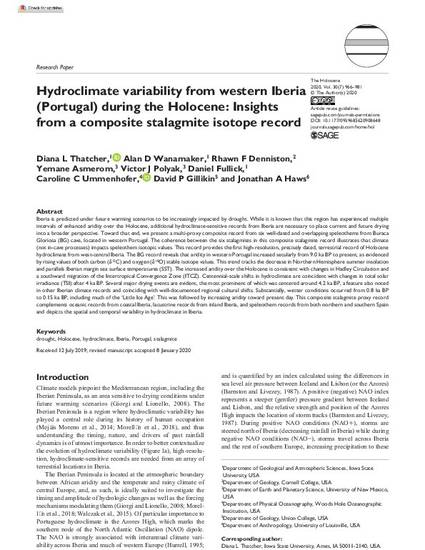
Iberia is predicted under future warming scenarios to be increasingly impacted by drought. While it is known that this region has experienced multiple intervals of enhanced aridity over the Holocene, additional hydroclimate-sensitive records from Iberia are necessary to place current and future drying into a broader perspective. Toward that end, we present a multi-proxy composite record from six well-dated and overlapping speleothems from Buraca Gloriosa (BG) cave, located in western Portugal. The coherence between the six stalagmites in this composite stalagmite record illustrates that climate (not in-cave processes) impacts speleothem isotopic values. This record provides the first high-resolution, precisely dated, terrestrial record of Holocene hydroclimate from west-central Iberia. The BG record reveals that aridity in western Portugal increased secularly from 9.0 ka BP to present, as evidenced by rising values of both carbon (δ13C) and oxygen (δ18O) stable isotope values. This trend tracks the decrease in Northern Hemisphere summer insolation and parallels Iberian margin sea surface temperatures (SST). The increased aridity over the Holocene is consistent with changes in Hadley Circulation and a southward migration of the Intertropical Convergence Zone (ITCZ). Centennial-scale shifts in hydroclimate are coincident with changes in total solar irradiance (TSI) after 4 ka BP. Several major drying events are evident, the most prominent of which was centered around 4.2 ka BP, a feature also noted in other Iberian climate records and coinciding with well-documented regional cultural shifts. Substantially, wetter conditions occurred from 0.8 ka BP to 0.15 ka BP, including much of the ‘Little Ice Age’. This was followed by increasing aridity toward present day. This composite stalagmite proxy record complements oceanic records from coastal Iberia, lacustrine records from inland Iberia, and speleothem records from both northern and southern Spain and depicts the spatial and temporal variability in hydroclimate in Iberia.
Available at: http://works.bepress.com/alan-wanamaker/19/

This article is published as Thatcher, Diana L., Alan D. Wanamaker, Rhawn F. Denniston, Yemane Asmerom, Victor J. Polyak, Daniel Fullick, Caroline C. Ummenhofer, David P. Gillikin, and Jonathan A. Haws. "Hydroclimate variability from western Iberia (Portugal) during the Holocene: Insights from a composite stalagmite isotope record." The Holocene 30 (2020): 966-981. doi: 10.1177/0959683620908648.